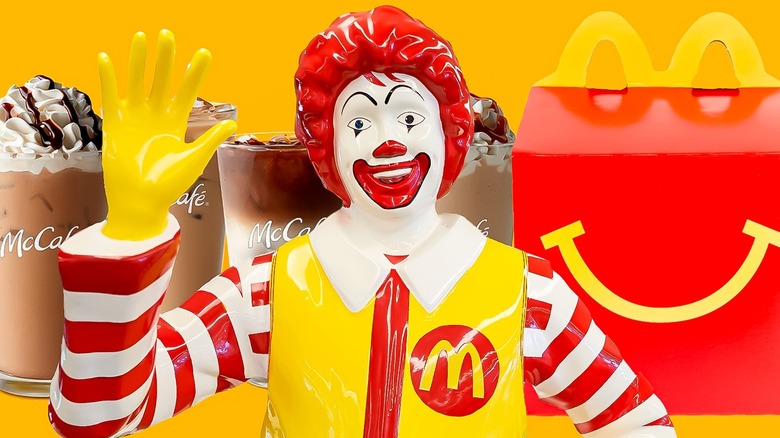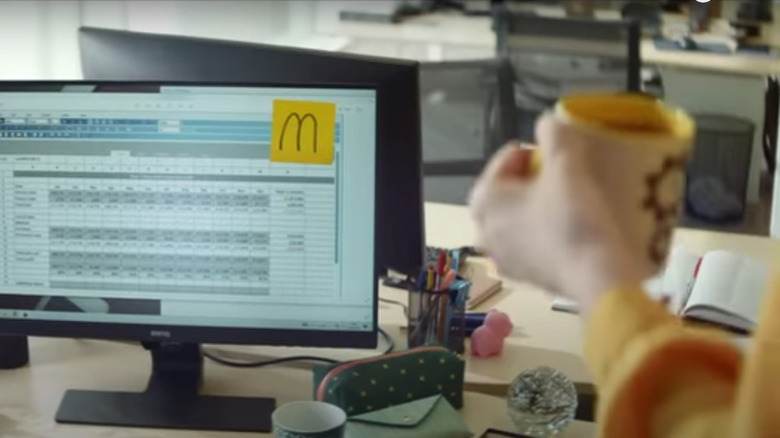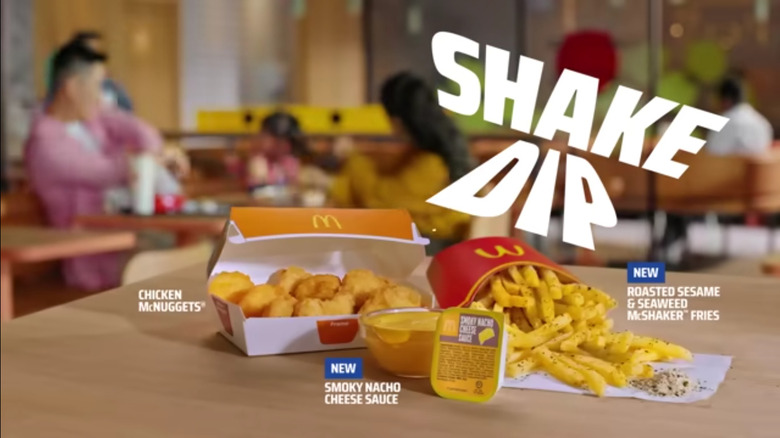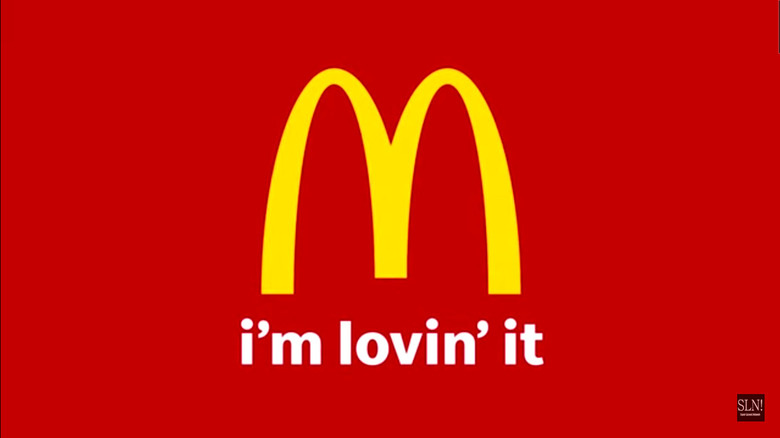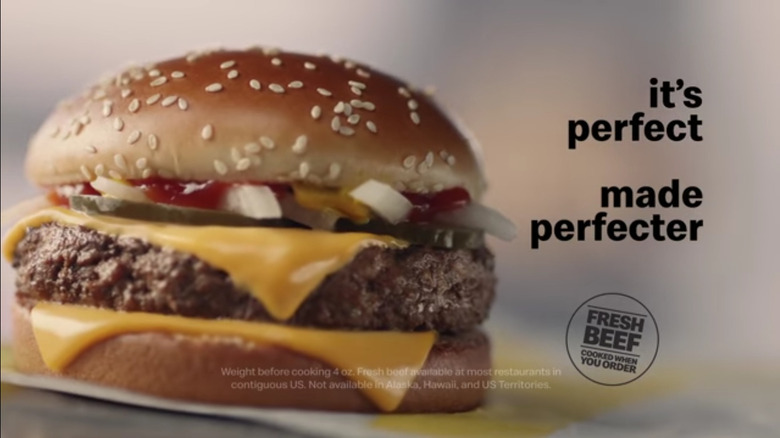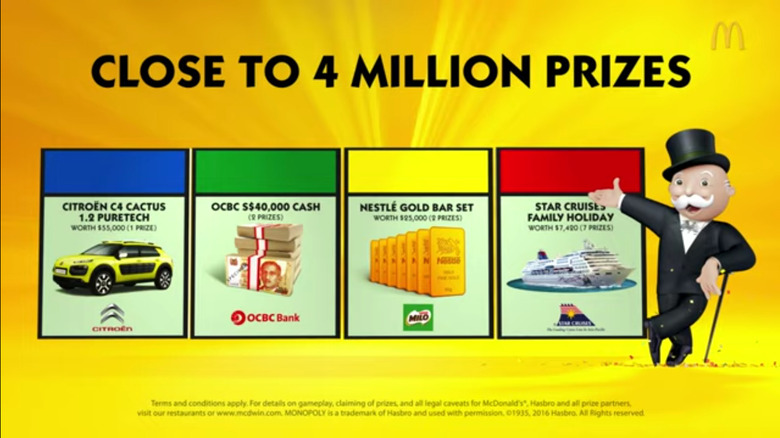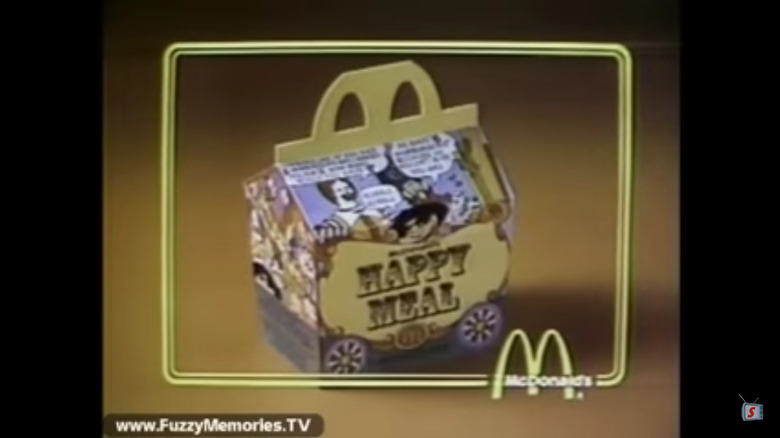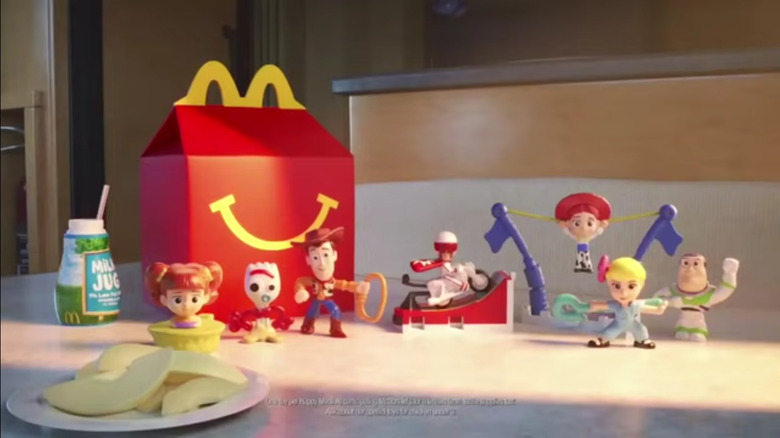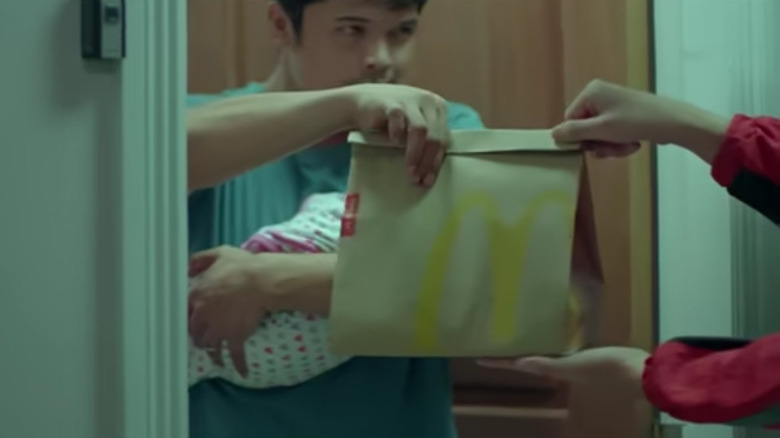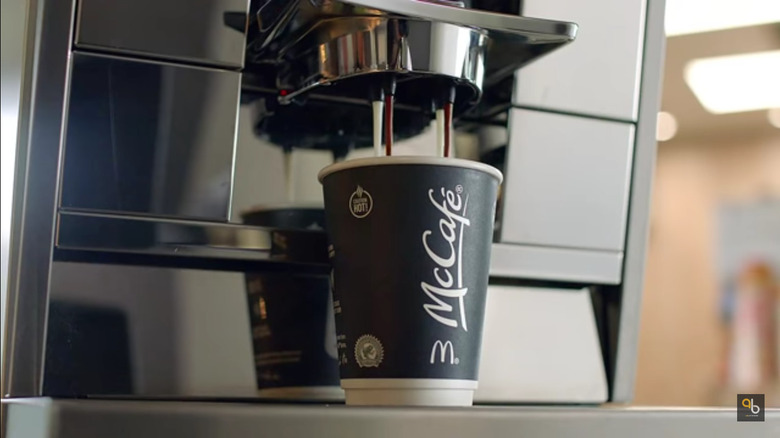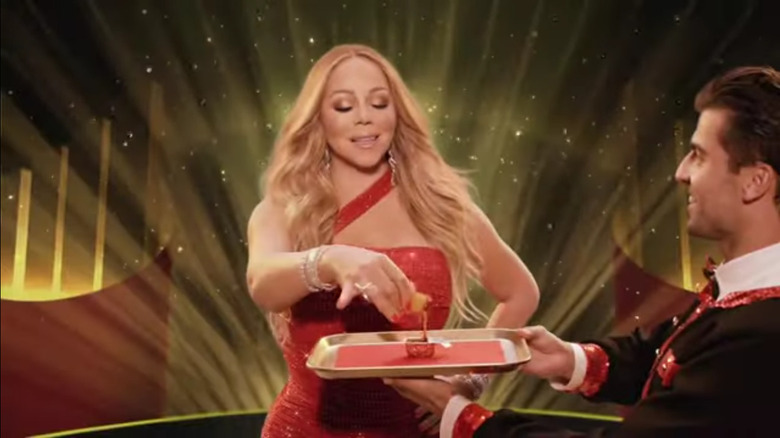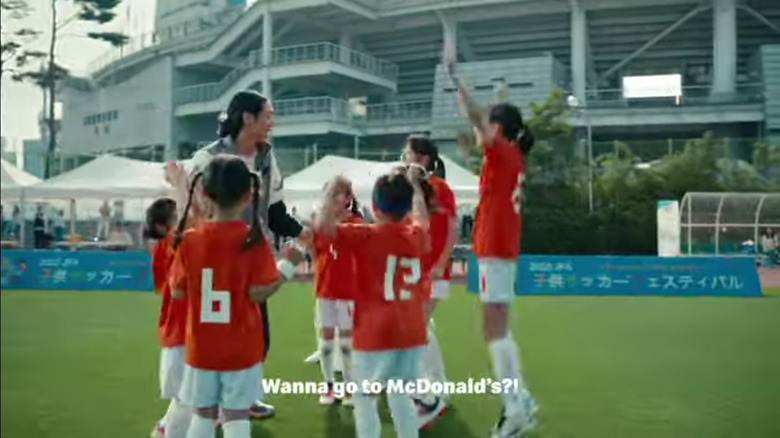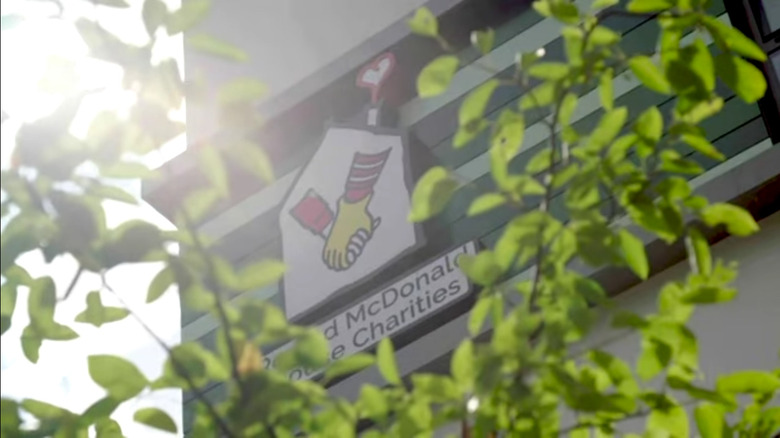The Most Savory McDonald's Marketing Campaigns Of All Time
In the 1950s, the American dinner table changed forever. Where once a family gathered to share a meal and stories of the day, an invader came, pushing families away from the dinner table and onto the couch. The invader? It was the TV set. Also during the 1950s, a place called McDonald's, which created an assembly-line burger in the same way that Henry Ford created an assembly-line car, saved dinner time — if not the dinner table — by offering fast food options that people could order quickly, and then take home to eat on TV trays in front of their beloved TV sets. A little more than a decade later, the loop that went from TV tray to drive-thru window to TV tray again solidified when McDonald's ran its first TV ad in 1963.
Given that fast food appealed to people who wanted to eat in front of the television, it seems only natural that McDonald's marketers continued to cook up ads designed to keep people coming back for seconds. And nowadays, those ads aren't just for prime time. McD's has a global audience that consumes content around the clock, and modern ads need to keep up with them. The success of these ads is measured in myriad ways, from bumps in sales numbers to an increase in app subscribers to viral video counts, with the best of them combining a number of success markers in one ad.
Raise Your Arches touched on nostalgia
In the early 1970s, McDonald's introduced its slogan "You deserve a break today," which inspired a generation of people to unchain themselves from their desks and go to McD's. In 2014, McDonald's abandoned the slogan that jingled Ronald McDonald into the collective consciousness, but it didn't leave the sentiment behind. Au contraire, mon frère! In its "Raise Your Arches" campaign, the hamburger giant still encourages people to take a break today, but now, it does so with the delicious naughtiness of Ferris Bueller when he took his famous day off.
In fact, it's "Oh, Yeah," the Yello song's famous "ch-ch-ch-kaaaaaaa's" and bomp-bomp attitude that introduces us to this eyebrow-raising ad. It's a stroke of nostalgia marketing genius that reaches the hearts of cinephiles everywhere, who remember the 1961 Ferrari 250 GT California scene from "Ferris Bueller's Day Off." Incredibly, the ad contains no fast food drive-throughs and no hamburgers. Yet, there's no doubt it's a McD's ad. Instead, it relies on a few key elements to pull this bad boy off: the raised eyebrows that emulate the golden arches, a hand-scrawled "M" on a sticky note, and the shot of the janitor's suspenders that gives a nod to McDonald's billboard ad campaign, featuring the golden arches as directional markers that point to the next McD's. With five million TikTok views and counting, "Raise Your Arches" was a viral marketing success.
Shake-N-Dip was a social media success in Singapore
Fast food companies like McDonald's have found themselves in a bit of a pickle recently. How can they market to a younger set of consumers, who'd rather play on Instagram and TikTok than watch TV? If those companies have some smarts, they'll put their money where the golden calf is: on social media. Given that most of us learn many important social mores via food rituals, there seem to be few better ways to socialize today's youth to eat fast food than to get a little help from some of the world's biggest influencers. That was the idea behind McD's "Shake-N-Dip" 2022 campaign.
Designed to attract dance challenge fans, the Shake 'N Dip ad for Singapore tapped social media stars Jamie Yeo and Bong Qiu Qiu, in the hopes that fans of the influencers would be inspired to create shake-n-dip videos for social media, all for the chance to earn a free ice cream cone. Substituting viral social media campaigns for TV and radio ads has worked so well that it likely explains why McDonald's overall ad spend for 2022 was down from the previous year, falling from nearly $460 million dollars in 2021 to $389 million in 2022. Why pay millions for TV and radio ads when fan-made videos garner between $200K and $400K in views for the price of an ice cream cone?
I'm Lovin' It is the gold standard
In the marketing world, there exists such a thing as A/B testing in which one ad – let's call it the "B" ad – gets pitted against another ad – the "A" ad – to see which pulls in the most leads or pageviews. Usually, the "A" ad is the gold standard by which all other ads are judged because that ad pulls in the big bucks year after year after year. It's the control. So it is with McD's "I'm lovin' it" ad campaign. For going on 20 years, some version of that ad has "ba da ba pa pa'd" its way around various media outlets across the globe.
In an essay in Brand Strategy Insider, former McDonald's CMO Larry Light lets us in on the secret to the ad's success: Consumers don't like to be told what to do. McDonald's former slogan "You deserve a break today" told consumers what to do – take a break, in this case. "I'm lovin' it" puts McD customers into the driver's seat by emphasizing the "I" instead of the "you" that dominated previous ads. This speaks to what psychologists call a shift from collectivism to individualism. It's a time when the pendulum swings from people focusing on society to focusing on their own lives. In McDonalds' case, it's a shift that people have been loving, to the tune of zillions of dollars, for decades.
Brian Cox turned the Quarter Pounder into a celebrity
You really have no chance of protecting yourself from fast food's lure. You know that, right? Fast food companies know that a juicy cheeseburger and greasy fries, which you wash down with poor man's champagne, tickle your brain until it barfs up enough dopamine to fill a bathtub. Given enough time, your brain responds to this hit in the same way it does coke – that's the drug coke, and not the brown bubbly stuff – with an addiction to all things fast food.
But that's not all fast food companies know. They – we're looking at you, McDonald's – know if you insert celebrities like "Succession" star Brian Cox into your ad, then consumers' brains are gonna light up again because evolution has trained humans to see people that we "know" as friends. Our lizard brains literally can't tell the difference between real friends and our imaginary TV ones. That's the beauty of celebrity endorsement. In one 30-second spot, by virtue of familiarity, a Shakespearean-trained thespian talks you into another cheeseburger.
While we don't know how much Brian Cox earned for the ad, you can bet it makes a lot for all concerned. As per USA Today, companies that feature a celebrity in their ads earn 4% more revenue than their competitors, which tells you just how lucrative LeBron's $500 million Nike deal must be if Nike can afford that payout.
McDonald's Monopoly hit the jackpot
Here's something to chew on. If you were to cook up an ad campaign that ensured that at least seven out of 10 of your customers would participate, what kind of campaign would it be? For McDonald's, that question is easy. Take nearly everyone's favorite childhood game, Monopoly, tack on the promise of hundreds of thousands of dollars and a free cheeseburger for good measure, and watch sales shoot through the roof for at least six weeks each year as people ride round and round through the drive-thru like the little white ball on the Roulette table.
Having run in some form since the late 1980s, Monopoly counts as one of McD's longest-running campaigns. With the addition of the peel-off game pieces and the chance to beat out your neighbor for $100,000, McDonald's Monopoly added a gamification element to the fast food giant's repertoire before the term "gamification" was even a thing. The campaign falls into the realm of contest marketing, which typically nets companies 34% more new customers per campaign. Further, contests convert higher than any other type of marketing content. For McDonald's customers, the chance to commandeer Boardwalk is too much to resist. Over the years, the fast food company's earnings from the game have added up to billions of dollars.
Happy Meals build multi-generation hamburger habits
Food and memories have been linked since time immemorial. It's this link that makes us homesick for our grandma's chicken fried steak recipe when we've had our fill of sushi in Asia, and it's the part of the human condition that the clever marketers at McDonald's count on when they're dreaming up a Happy Meal combo for their next ad campaign. As former McDonald's CEO Steve Easterbrook explained, Happy Meals create "lasting memories" that kids and their cheeseburger-lovin' parents can share. That is, parents love the portable toy box with the side of chicken nuggets so much they want to share the experience with their kids in much the same way that your grandma shared her chicken fried steak recipe with you.
This sharing of food memories isn't without its problems. According to the American Psychological Association (APA), research links high rates of childhood obesity with the influence of kiddie-oriented food ads, which have an estimated ad spend of $17 billion per year. Ironically, it's the growing rates of childhood obesity that prove just how effective these ads are.
Savvy government officials in places like San Fransisco have tried to get around this by banning meals that come with free toys. The deterrent didn't last. McDonald's added a 10-cent toy surcharge to its Happy Meals, doing away with free toys in the meal boxes and ensuring a steady stream of customers for generations to come.
Toy Story takes kids from the movies to dinner in one sitting
Movie tie-in licensing deals turn what would have been two hours of entertainment into a two-hour commercial. Few companies do this better than McDonald's. Case in point? The McDonald's/"Toy Story" licensing partnership. Really, it's the kind of brand partnership that's made in Hollywood heaven, given that Pixar's movie is about toys come to life and given that toys play a central role in the popularity of McDonald's Happy Meals. As Deadline reported, the brand licensing deal between Disney/Pixar and McDonald's for "Toy Story 4" was part of a larger $150 million ad spend that saw Disney/Pixar partnering with at least 100 global brands to promote the movie about Woody's and Buzz's adventures. At the time of the writing of the Deadline piece, the deal represented the largest one ever for Disney/Pixar.
And while the stories of the "Toy Story" franchise may not be brand journalism – something that former McD's CMO Larry Light admitted was part of his brand strategy – it comes awfully close. Brand journalism strives to tell a brand's story not by using cold facts and figures but by introducing stories into the conversation around the brand, something that Disney/Pixar excels at. And certainly, "Toy Story" fits nicely into McDonald's primary market demographics – kids, young adults, and moms – making this ad one that's likely to shoot McDonald's into infinity and beyond for years to come.
McDonald's delivers food and convenience
In the 1950s, restaurants faced many nights with empty booths, all because the TV set had become ubiquitous in American homes. While the American public felt content to sit around watching "I Love Lucy," the burgers in diners everywhere got stale. Enter food delivery and takeout. The New York Times reported that savvy restauranteurs who offered such services saw their profits start to bubble up, by as much as 50% for some eateries.
We bring this food history lesson up because, in recent years, restaurants again faced the prospect of empty booths. When the pandemic hit in 2020, once again food delivery and takeout came to the rescue. During the pandemic, McDonald's same-store sales fell by nearly 25% worldwide in the second quarter as they shuttered their doors in response to stay-at-home policies. However, in the latter part of the year, McDonald's made a fast pivot. This leaned heavily on ads, food-related apps, and delivery services through DoorDash and GrubHub, which allowed McD's to regain its financial equilibrium by September.
And although McDonald's hit a few snags with the home delivery campaign, including having to agree to a higher commission clause in its DoorDash contract, restaurant sales for the burger giant have begun to heat up once again, thanks to some savvy marketing and a fleet of eager delivery drivers.
McCafé commandeers the coffee market
For decades, the name McDonald's and hamburgers have been synonymous. The company's dominance of the fast food niche allowed lunch-goers to quickly identify their best lunch bets. It also allowed Starbucks coffee houses to cozy up to book lovers that mixed their afternoon coffee with a good novel. While McDonald's always offered a working man's cuppa joe for the morning rush crowd, ne'er hath the twain – McDonald's and Starbucks – met in any significant way in the coffee market until recently. Things changed when McDonald's threw its cup on the table as a froofy iced and flavored coffee contender.
Although the morning crowd loves Starbucks, the coffee chain falters when it comes to competing with McD's afternoon food offerings. Meanwhile, the addition of more Starbucks-like coffee offerings to McDonald's menu, including frozen cappuccinos and mocha lattes, means the burger giant rakes $13 million in daily coffee sales. What's more, at $2 for a small coffee drink, McDonald's makes coffee friendlier to the average Joe's pocket. All of this is conveyed in McDonald's coffee ads, like "We Could" which appeals to people from all walks of life — it talks about all the fancy things a McD's ad could mention but instead, shows how its plain arabica coffee is just right for consumers.
Mariah Carey cheers up 12 days of Christmas at McD's
On the first day of Christmas, my true love gave to me a free Big Mac from Mariah Carey-ey-ey ... Of course, anyone who knows how to read the fine print knows that free isn't really free in the fast food world. It's a loss leader. The Mariah Menu, which McDonald's introduced in 2021, required a purchase valued at least a dollar before consumers got their "free" Big Mac, McChicken, hotcakes, and more. And the only way McD's customers could take advantage of this promo was via the company's app.
So, why all the hoop-jumping just to give away a not-so-free burger via a digital app? As the Motley Fool reported, McDonald's digital sales from the burger giant's big six markets equaled $18 billion dollars in 2021. The company's Q4 earnings were also up by 13% in the same year. Unlike when they're in the store, online apps also allow restaurants like McDonald's to unobtrusively nab customer data, offering them the chance to better design their marketing campaigns in the future. And while fast food restaurants typically see an uptick in sales during the holiday season, it's also likely that some of McDonald's big year-end earnings had to do with the 12 days of freebies on the Mariah Menu.
McDonald's and FIFA unite cultures under the golden arches
There are 195 countries in the world, and McDonald's is in more than half of them. This isn't much of a challenge when McDonald's headquarters creates an ad campaign for America or for Germany or for China. It is a BIG challenge when the world's largest fast-food chain creates a global ad campaign. It runs into language barriers and cultural barriers and time zone considerations that would challenge even the best video game localization experts. (We see you, "World of Warcraft.")
As it turns out, the world of games, and not just worldwide video games, provided McDonald's with the "in" that it needed to reach 'round the world. McDonald's FIFA World Cup "Wanna Go to McDonald's" ad in 2022 featured celebrities from around the world, including notables like "Ted Lasso's" Jason Sudeikis and K-Pop star ITSY, almost a dozen languages, and shots of soccer fans in dozens of locales, asking "Wanna go to McDonald's?" The success of McDonald's largest global ad campaign arose from its power to find common ground – or a common field, in this case.
Ronald McDonald creates a haven for the sick
If you've spent an extended length of time around a hospital, it's likely that you've seen the local Ronald McDonald House® or one of the related charities. And while McD's does produce ads that educate the public about Ronald McDonald House® services, the success of this program doesn't center on the ad campaigns for this program, though they likely help, but on the success of the ads from another well-known McDonald's product: the Happy Meal.
According to the McDonald's website, a portion of the proceeds from the sale of each box – one cent, or basically 1% of each dollar – funds these havens for the families of sick children. Lest you be tempted to think that one cent per meal is chump change, consider this: A 2018 Forbes article reports that McDonald's made $10 million a day on its Happy Meal programs in 2017, and while it's been a few years since 2017, the figure provides us with a rough estimate of just how much Happy Meal sales bring to the charitable table. One percent of $10 million is $100,000 a day. In 365 days of the year, that daily $100K morphs into $36+ million by year's end – not chump change at all.
